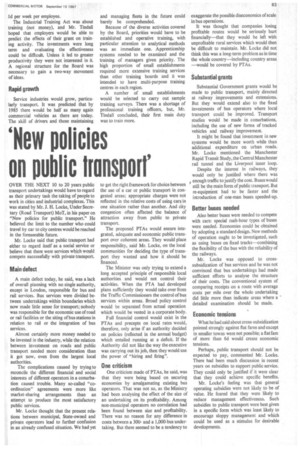`Training for a dynamic industry'
Page 84

Page 85

If you've noticed an error in this article please click here to report it so we can fix it.
MR. T. E. TINDALL, director-general, Road Transport Industry Training Board, in his paper on "Training for a dynamic industry" said that most people assumed his Board's main responsibilities were for training drivers and maintenance craftsmen. In fact the Board was equally concerned with training in all occupations. Managing a bus company had much in common with running any other transport undertaking or organization.
The most urgent need was to analyse the needs of the industry qualitatively and quantitatively. The areas where training was most needed had to be identified. The evidence so far was that the level of formal training compared unfavourably with the manufacturing industries—a result of the industry's youthfulness and the size of constituent companies.
In road haulage, 39,000 out of 46,000 establishments had five or less vehicles and all had labour problems. He believed that the Board could show that training was an investment for the future.
If the road transport industry required talent and ability, said Mr. Tindall, it had to recruit university graduates and he doubted whether municipal transport obtained as many as 20 a year. Yet the industry was larger and more important than many others recruiting graduates in larger numbers.
Mr. Tindall pointed out that the levy scheme would represent 1.6 per cent of the payroll of each establishment, the first instalment of 0.5 per cent falling due in October, 1967, and the second (1.1 per cent) in Feb ruary, 1968. The Board had done its utmost to reduce the period during which they would take money from the industry. That was the reason for the uneven breakdown of the two instalments.
First grant claim The first grant claim for training could be made in January, 1968, and would relate to the period from August 1, 1967. The second claim could be made from August 1, 1968. The aim was to fix a price on all training activities but for the first year the grant scheme would limit itself to contributions for current training costs. The Board's present administrative costs were roughly a Id per week per employee.
The Industrial Training Act was about training (not money), and Mr. Tindall hoped that employers would be able to predict the effects of their grant on training activity. The investments were long term and evaluating the effectiveness could be difficult. Unless it led to greater productivity they were not interested in it. A regional structure for the Board was necessary to gain a two-way movement of ideas.
Rapid growth
Service industries would grow, particularly transport. It was predicted that by 1985 there would be half as many again commercial vehicles as there are today. The skill of drivers and those maintaining and managing fleets in the future could barely be comprehended.
Because of the diverse activities covered by the Board, priorities would have to be established and operative training, with particular attention to analytical methods was an immediate one. Apprenticeship systems needed to be examined and the training of managers given priority. The high proportion of small establishments required more extensive training services than other training boards and it was intended to have multi-purpose training centres in each region.
A number of small establishments would be selected to carry out sample training surveys. There was a shortage of professional training officers, but, Mr. Tindall concluded, their first main duty was to train more.




































































































































